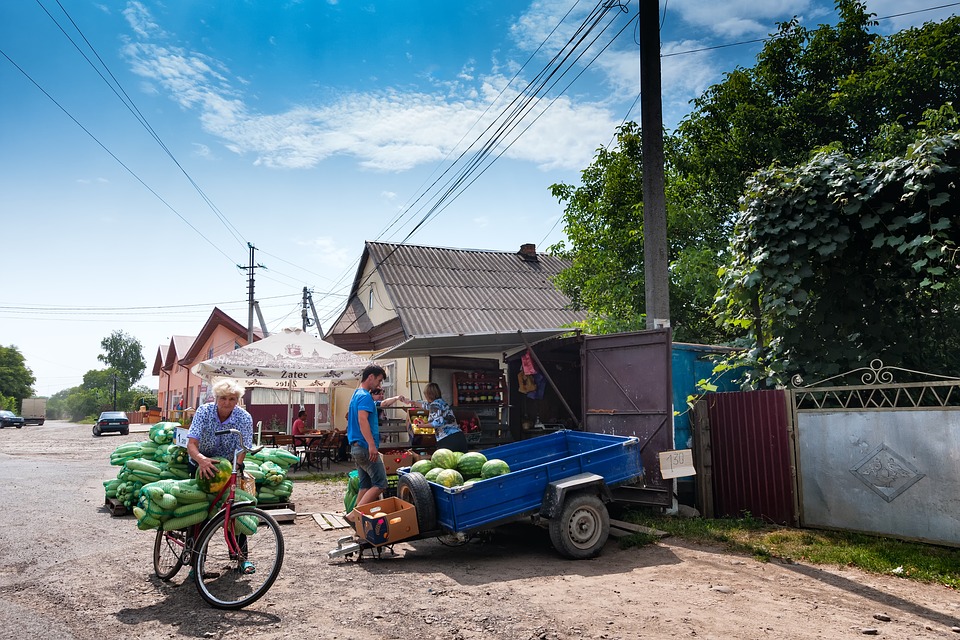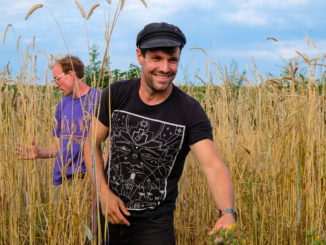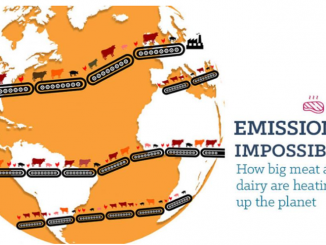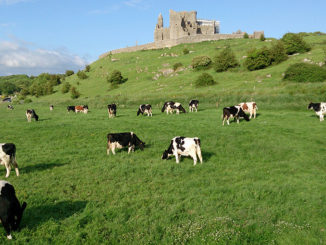
By Natalia Mamonova (1,2)
While peasants worldwide have united in social movements to fight land grabbing and protect their right to an adequate standard of living, including their right to food and right to land, the post-Soviet rural population, such as in Ukraine, has so far not expressed outright resistance to large-scale agricultural development, and the peasants’ rights discourse has been absent.
This article examines Ukrainian peasants’ responses to land grabs and agribusiness expansion. It discusses the post-Soviet context, forms of incorporation of the rural population in land deals, the lack of rural protests and mobilization, and the prospects for small-scale agriculture in the country.
Land Grabbing and the absence of peasant resistance
The World Bank recently included Ukraine in the list of resource-rich and finance- poor countries that have become targets for land grabbing. The country possesses more than 25% of the world’s richest and most fertile soil, ‘Black Earth’, and was the Soviet Union’s ‘breadbasket’. After the collapse of the Soviet Union in 1991, Ukraine undertook a land reform to break down the collective farms and distribute their lands to rural dwellers to help develop private farming. However, since all the other important factors (such as capital, know-how, upstream and downstream markets, and the rule of law) disappeared with the breakdown of the collectives, rural dwellers could not effectively use their land. Instead, land became concentrated: first in the hands of rural elites and later accumulated by large domestic and foreign investors that were motivated by the upswing in world food markets and the global land rush of the early 2000s. To date 60% of Ukrainian farmland is controlled by large agribusinesses, whose size and scale are comparable with the largest latifundia (3) in Brazil and Argentina.(4) The sale of agricultural land is prohibited in Ukraine until January 2016.(5) Agribusinesses, therefore, rent land from the rural population (usually at unfavorable rates for the latter) or resort to illegal schemes to acquire land.
This expansion of land grabbing and agribusiness did not face outright resistance from the rural population. Instead, many rural Ukrainians rent out the distributed land to agribusinesses, while they cultivate tiny household plots (on average 0.4 hectares). Rural households only use 12% of Ukrainian farmland in total, but contribute to 52.7% of the gross domestic agricultural output. They produce 98% of the total harvest of potatoes, 86% of vegetables, 85% of fruits, and 81% of milk.(6) The Ukrainian government largely overlooks the importance of population farming in its agricultural policy and instead supports agribusinesses. In 2012, 60% of all State subsidies to agri- culture went to large businesses.(7) Meanwhile, the rural population is on the brink of poverty with 44% having incomes below the subsistence minimum and 7% experiencing malnutrition.(8)
The lack of open protest among the post-Soviet population is often explained by 70 years of socialism, during which expressions of disagreement with governmen- tal actions were prosecuted, and serious protest led to being deported to work in the Gulag labor camp. The Ukrainian countryside is also currently experiencing an exodus of young and active residents who migrate to urban areas leaving behind the older population. Just over 24% of rural Ukrainians are over 60. Nevertheless, while these are important factors, our analysis suggests that the main reasons for this ‘quietness’ are: (1) the continuity of a dual agrarian structure, and the absence of conditions for commercial family farming; (2) the partial inclusion of rural households in land deals and large-scale agricultural development; and (3) the adaptability of peasant farming allowing it to persist in a hostile environment.
Peasants and Large Scale Agricultural Development
The bifurcated ‘Soviet-like’ agrarian structure remained in Ukraine despite the post- socialist land distribution: former collectives have been gradually transformed into large agribusinesses, while rural dwellers continue subsistence farming with their household plots, albeit with fewer opportunities for wage-work. Land grabbing was carried out without the physical displacement of the rural population.
When the large companies arrived in the Ukrainian countryside in the 2000s, rural socio-economic conditions were deplorable. The de-collectivization process of the 1990s caused:
1) a 40% rate of rural unemployment;
2) the disappearance of formal and informal support to households (previously, households were allowed to use collective facilities, such as pastures, machinery, and input; and pilfering from collective fields was socially accepted); and
3) a deterioration in rural infrastructure, which was formally part of the collectives’ responsibilities.
The domestic and foreign agribusinesses revitalized large-scale agricultural production, converting Ukraine into one of the world’s leading agro-food exporters. The new agricultural operators not only took over the land, but also several social functions of the former collectives. Some functions are performed in order to prevent sabotage to agribusinesses’ fields. Other functions are required by Ukrainian land law, which does not allow companies to own agricultural land. Since agribusinesses have to rent the land from peasants, they partly incorporate the rural population into large- scale agricultural development. The rental agreements imply a small (in-kind) payment to the landowners with almost no termination or renegotiation options. However, these payments are an important additional income for many rural households.
The lack of small-scale farm development programs, widespread corruption, and power discrepancies discourage peasants from using the distributed land for commercial farming. Moreover, due to the socialist tradition of industrial farming, many rural Ukrainians regard themselves primarily as workers rather than land-owners, and believe that the agricultural land should be cultivated collectively. These factors define the peasants’ preference for wage-jobs at agribusinesses rather than establishing independent family farms. According to the FAO Farm Survey of 2005, 96% of Ukrainian villagers did not want to start individual farming; 20% of those surveyed had a job; and 26% desired an agricultural wage-job.(9) Rural workers also benefit from additional services provided by their employers (e.g. discounted farm input and output, assistance with ploughing, etc.). Rural families with at least one member employed at agribusinesses have the lowest poverty risk.
However, not everyone is integrated into large-scale agricultural development. Rural unemployment remains high. In 2004, 10% of the working-age rural population was unemployed (10). A number of rural households also do not receive rent payments. These include those who did not receive land plots during the land distribution, i.e. rural teachers, medical staff, postal workers, and those who sold their land in the early 1990s. Furthermore, a small group of commercial family farmers have experienced severe difficulties from the large agribusiness expansion. Large agribusinesses control food markets, the value chain and farmland distribution, and also receive the majority of State subsidies. This leaves limited opportunities for family farmers to grow and succeed.
Adaptation and Persistence of Peasant Households
The adaptability of rural households is the other factor explaining the lack of rural protests against land grabs and large-scale agricultural development. Peasants are able to adapt their agricultural production to ensure that it does not overlap with the interests of agribusiness. After the collapse of the Soviet Union, rural household production has more than doubled. Before peasants produced almost everything for their subsistence needs, including wheat and other crops. Nevertheless, with the agribusiness expansion, peasants had to change their production strategy. The agribusinesses are interested in export-oriented monocrop (primarily wheat, barley and maize) production and neglect labor and time-intensive and less profitable agriculture such as potatoes, vegetables, fruits, meat, and dairy. Peasants took over this market niche and intensified the production of related foods. Today rural households meet their families’ needs with these products and sell the surplus on domestic markets. This market segmentation contributes to a fragile coexistence of large-scale agriculture with peasant farming.
However, if the interests of peasants and agribusinesses collide, the latter resort to predator politics to eliminate their competitors. The current State program supporting the industrialization of milk and meat production attracted agribusiness to this sector at the expense of rural households. Rural households are unable to meet the recently introduced sanitary requirements for keeping and slaughtering animals, and the annual epidemics of swine flu have led to a mass slaughtering of pigs. Peasants see these moves as a war against them.
Furthermore, the system of organized peasant food markets is underdeveloped in Ukraine. The majority of potatoes, fruits and vegetables produced by peasants are sold at improvised markets or on the roadside. Dairy and meat products require certification and can only be sold at official market places that are inaccessible and unaffordable to many peasants, or must be collected by intermediaries or processing plants. The collectors’ procurement prices are very low, often below peasants’ production costs. The absence of efficient protection mechanisms for small-scale farmers and a highly monopolized and criminalized collection business (especially for milk) means that peasants are unable to bargain for a higher price. In 2012, many peasants decided to take action and protested against the low milk procurement prices in front of local administration offices in several Ukrainian regions. Nevertheless, protesters did not manage to change the situation. In fact, several participants experienced threats, militia control checks, and even legal prosecution as a result of their protest.
Subsequently, people believed there was a ‘milk mafia’ and State-agribusiness collusion. Despite the predatory politics of large agribusiness and the State policy to ‘modernize’ agriculture in an agro-industrial way, peasant households persist and show a phenomenal ability to survive in hard times. While the economic crisis of 2007–2008, and the ongoing civil war that started in 2014, caused severe financial difficulties for many agribusinesses, peasants diversified their activities and became almost self-sufficient. The persistence of the peasant mode of production is defined by the use of family labor, self-controlled resources, informal networks for food distribution, and traditional forms of land cultivation, which do not require significant input or advanced machinery. Peasants produce their food manually and use primarily organic fertilizers. Moreover, social relations and mutual support play an important role in food sharing and distribution practices.
Academics and practitioners often discuss the sustainable small-scale food production in other countries as an alternative to the corporate food regime. These discourses are, however, absent in the post-Soviet countryside (11). The Ukrainian rural population considers their farming not as an alternative, but rather as subsidiary to industrial farming. Rural civil society organizations that could generate ideas about peasant rights and sovereignty are scarce, and lack support from the rural population (12). There are ongoing academic and political debates about whether the post-Soviet bifurcated agrarian structure will remain stable or transform into a monopolistic agricultural model (13). Until land sales are allowed, large agribusinesses will continue operating on peasant land. However, the liberalization of the land market is expected within the program of European Union (EU) integration. In this process, both Europe and the Ukrainian government should protect the small-scale producers and recognize their important contribution to the availability of a more diverse range of nutritious products on the market. This would protect both the rights of producers and consumers.
This article was originally published in the 2015 issue of the Right to Food and Nutrition Watch, titled “Peoples’ Nutrition Is Not a Business”, available (in English, Spanish, French and Portuguese) here: www.righttofoodandnutrition.org/peoples-nutrition-not-business
1.This article is largely based on the academic research conducted by the author in 2012–2014 in Central and Western Ukraine. For more information, see: Mamonova, Natalia. “Resistance or Adaptation? Ukrainian Peasants’ Responses to Large-Scale Land Acquisitions”. Journal of Peasant Studies 42:3–4 (2015): 607–634.
2. Natalia Mamonova is a PhD candidate in Development Studies at the International Institute of Social Studies (ISS) of Erasmus University. Special thanks to Christina Plank (University of Vienna), Antonio Onorati (Centro Internazionale Crocevia), Priscilla Claeys (University of Louvain and French Institute of Pondicherry) and Stineke Oenema (ICCO Cooperation) for their support in reviewing this article. This article was originally written in English.
3. A latifundium is a large landed estate or ranch typically worked by peasants or people working under conditions of modern
4. Lapa, Volodymyr, Alexej Lissitsa and Andriy “Super-Large Farms in Ukraine and Land Market.” Paper presented at annual IAMO Forum, Germany, June 25–27, 2008.
5. For more information on the land market in Ukraine, please see insight box below
6. State Statistics Committee of Ukraine. Production of Major Agricultural Products. Available at: www.ukrstat.gov.ua.
7. Lapa, Volodymyr. General Director of the Ukrainian Agribusiness Interview with author, Kiev, July 22, 2012.
8. Vlasenko, Nataliya “Rural Poverty in Ukraine.” Problems of Economic Transition 51:7 (2008): 21–28.
9. Zvi Lerman et , Ukraine after 2000:
A Fundamental Change in Land and Farm Policy? Rome: FAO, 2006. Available at: departments.agri.huji.ac.il/economics/ lerman-fao-study.pdf.
10. State Employment Service. Economically Active Population, 2014. Available in Ukrainian at: dcz.gov.ua.
11. The discussion on efficiency and sustain- ability of the post-Soviet peasant farming can be found in Oane Visser et , “ ‘Quiet Food Sovereignty’ as Food Sovereignty without a Movement? Insights from Post- socialist Russia.” Globalizations 12:4 (2015): 513–528.
12. Visser, Oane, and Natalia Mamonova. Large-Scale Land Acquisitions in the Former Soviet A Study of Rural Social Move- ments and Land Conflicts in Russia and Ukraine. IS Land Academy, 2011.
13. Mamonova, Natalia. “Challenging the Dominant Assumptions About Peasants’ Responses to Land Grabbing: A Study of Diverse Political Reactions from Below on the Example of ” Paper presented at the International Conference on Global Land Grabbing II, Cornell University, Ithaca, October 17–19, 2012.





